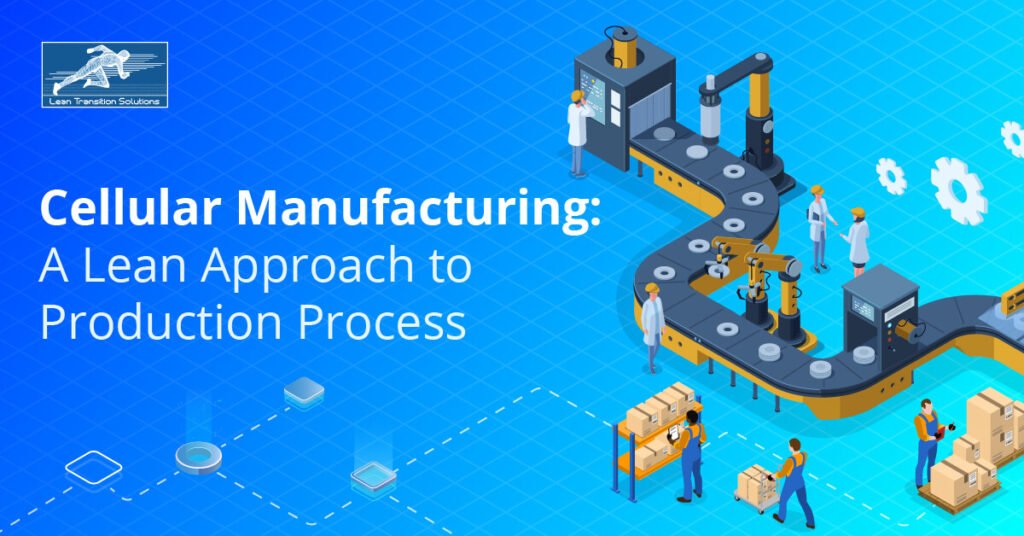
Cellular manufacturing is a production system that combines the processes of a production line into a single, unified manufacturing cell. It is a type of lean manufacturing system that reduces waste and improves efficiency. It achieves this by reducing the time it takes to transfer products between machines.
In cellular manufacturing, production work stations and equipment are arranged in a sequence that supports a smooth flow of materials and components through the production process with minimal transport or delay. Implementation of this lean method often represents the first major shift in production activity, and it is the key enabler of increased production velocity and flexibility, as well as the reduction of capital requirements.
Rather than processing multiple parts before sending them on to the next machine or process step (as is the case in batch-and-queue, or large-lot production), cellular manufacturing aims to move products through the manufacturing process one-piece at a time, at a rate determined by customers’ needs.
Cellular manufacturing can also provide companies with the flexibility to vary product type or features on the production line in response to specific customer demands. The approach seeks to minimize the time it takes for a single product to flow through the entire production process.
This one-piece flow method includes specific analytical techniques for assessing current operations and designing a new cell-based manufacturing layout that will shorten cycle times and changeover times.
To make the cellular design work, an organization must often replace large, high volume production machines with small, flexible, “right-sized” machines to fit well in the cell. Equipment often must be modified to stop and signal when a cycle is complete or when problems occur, using a technique called autonomation (or jidoka).
This transformation often shifts worker responsibilities from watching a single machine, to managing multiple machines in a production cell. While plant-floor workers may need to feed or unload pieces at the beginning or end of the process sequence, they are generally freed to focus on implementing TPM and process improvements.
Using this technique, production capacity can be incrementally increased or decreased by adding or removing production cells.
Cellular manufacturing requires a fundamental paradigm shift from “batch and queue” mass production to production systems based on a product aligned “one-piece flow, pull production” system.
Batch and queue systems involve mass-production of large inventories in advance, where each functional department is designed to minimize marginal unit cost through large production runs of similar product with minimal tooling changes.
Batch and queue entails the use of large machines, large production volumes, and long production runs.
The system also requires companies to produce products based on potential or predicted customer demands, rather than actual demand, due to the lag-time associated with producing goods by batch and queue functional department. In many instances this system can be highly inefficient and wasteful. Primarily, this is due to substantial “work-in-process”, or WIP, being placed on hold while other functional departments complete their units, as well as the carrying costs and building space associated with built-up WIP on the factory floor.
To the left illustrates the production flow in a batch-and-queue system, where the process begins with a large batch of units from the parts supplier. The parts make their way through the various functional departments in large “lots”, until the assembled products eventually are shipped to the customer.
The following steps and techniques are commonly used to implement the conversion to cellular manufacturing.
Step 1: Understanding the Current Conditions.
Step 2: Converting to a Process-based Layout.
Several techniques are important to facilitate effective cellular layout design and production.
SMED. Single-minute exchange of die (SMED) enables an organization to quickly convert a machine or process to produce a different product type.
A single cell and set of tools can therefore produce a variety of products without the time consuming equipment changeover and set-up time associated with large batch-and-queue processes, enabling the organization to quickly respond to changes in customer demand.
Autonomation.
Autonomation is the transfer of human intelligence to automated machinery so that machines are able to stop, start, load, and unload automatically. In many cases, machines can also be designed to detect the production of a defective part, stop themselves, and signal for help. This frees operators for other value-added work. This concept has also been known as “automation with a human touch” and jidoka, and it was pioneered by Sakichi Toyoda in the early 1900s when he invented automatic looms that stopped instantly when any thread broke.
This enabled one operator to manage many machines without risk of producing vast amounts of defective cloth. This technique is closely linked to mistake-proofing, or poka-yoke (see TPM method profile).
Right-sized equipment. Conversion to a cellular layout frequently entails the replacement of large equipment (sometimes referred to as monuments) with smaller equipment. Right-sized equipment is often mobile, so that it can quickly be reconfigured into a different cellular layout in a different location. In some cases, equipment vendors offer right-sized equipment alternatives, and in other cases companies develop such equipment in-house. A rule of thumb is that machines need not be more than three times larger than the part they are intended to produce.
Step 3: Continuously Improving the Process.
This step involves fine tuning all aspects of cell operation to further improve production time, quality, and costs. Kaizen, TPM, and Six Sigma are commonly used as continuous improvement tools for reducing equipment-related losses such as downtime, speed reduction, and defects by stabilizing and improving equipment conditions (see Kaizen, TPM, and Six Sigma method profiles). In some cases, organizations seek to pursue a more systemic redesign of a production process to make a “quantum leap” with regard to production efficiencies and performance. Production Preparation Process (3P) is increasingly used as a method to achieve such improvement.
Potential Benefits of Cellular Manufacturing :
Cellular production helps to eliminate overproduction. Overproduction impacts the environment in three key ways:
increases the number of products that must be scrapped or discarded as waste;
increases the amount of raw materials used in production;increases the amount of energy, emissions, and wastes (solid and hazardous) that are generated by the processing of the unneeded output.
Cellular manufacturing helps reduce waste by reducing defects that result from processing and product changeovers. Since products or components move through a cell one piece at a time, operators can quickly identify and address defects.
Autonomation (jidoka) in cellular systems helps prevent waste by signaling when defects occur. Under a conventional batch-and-queue process, it is difficult to identify and respond to defects until the entire batch is produced or numerous pieces are processed. Reducing defects has several environmental benefits:
fewer defects decreases the number of products that must be scrapped;fewer defects also means that the raw materials, energy, and resulting waste associated with the scrap are eliminated;
fewer defects decreases the amount of energy, raw material, and wastes that are used or generated to fix defective products that can be re-worked.
Shifting to right-sized equipment means that production equipment is sized to work best for the specific product mix being produced, as opposed to the equipment that would meet the largest possible projected production volume. Right-sized equipment typically less material and energy-intensive (per unit of production) than conventional, large-scale equipment.
Cellular production layouts typically require less floor space for equal levels of production (“this is a factory, not a warehouse”). Reductions in square footage can reduce energy use for heating, air conditioning, and lighting. Reduced square footage can also reduce the resource consumption and waste associated with maintaining the unneeded space (e.g., fluorescent bulbs, cleaning supplies). Even more significantly, reducing the spatial footprint of production can reduce the need to construct additional production facilities, as well as the associated environmental impacts resulting from construction material use, land use, and construction wastes.
Cellular manufacturing layouts and autonomation can free workers to focus more closely on equipment maintenance (TPM) and pollution prevention, reducing the likelihood of spills and accidents.
Potential Shortcomings of Cellular Manufacturing :
Switching to cellular manufacturing systems can require investment in new equipment, and potentially, the need to scrap the older, large-scale equipment geared more to batch-and-queue operations. This can produce scrap for recycling and/or waste.
Right-sizing and dispersing environmentally-sensitive production processes throughout a plant can disrupt conventional pollution control systems. For example, shifts to cellular production is often accompanied by a shift to disperse, point-of-use chemical and waste management, which requires an adjustment in chemical and waste management practices. Similarly, shifts to multiple, right-sized painting and coating, parts washing, or chemical milling operations can alter air emissions control approaches, needs, and requirements. If environmental requirements are not addressed sufficiently during the conversion to cellular layouts and right-sized equipment, the organization can impact the environment adversely and/or fail to comply with applicable regulatory requirements.
